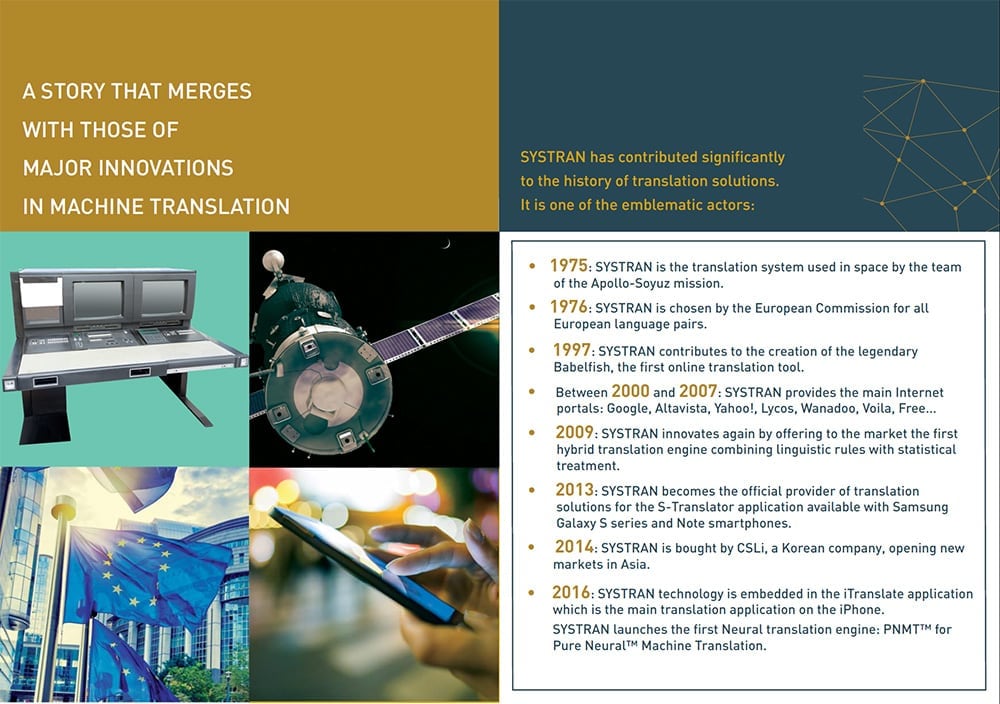Las tecnologías que usamos

SDL Trados Studio 2017
SDL Trados Studio 2017 es una herramienta de traducción asistida por computadora completa para profesionales lingüísticos que desean editar y revisar proyectos con la terminología establecida. Es utilizada por más de 250 000 profesionales en todo el mundo.
Entre las nuevas características y funciones de SDL Trados Studio 2017 está AdaptiveMT que aprende de las post-ediciones, trabajo a trabajo, para que los resultados de la traducción automática se adapten de forma única a su tono, terminología y estilo lingüístico.

Pure Neural™ Machine Translation
Esta tecnología, basada en algoritmos complejos a la vanguardia del aprendizaje profundo, le permite al motor de PNMT™ (Traducción Automática de Pure Neural™) aprender, generar reglas idiomáticas a partir de un determinado texto traducido y, a continuación, producir una traducción que supera a la actual y a la realizada por un hablante no nativo.

G Suite
G Suite ofrece un proceso optimizado que garantiza que todo sea fácil de gestionar. Cuando se trabaja desde tres oficinas, la sincronización de la información es importante. Nos permite colaborar de forma remota sin correr peligro de perder datos o documentos. Esto se debe a que todos los cambios se guardan en tiempo real en una nube de Google y realiza al mismo tiempo una copia de seguridad.
First, machine translation. Now? Pure neural machine translation
Unlike the engines behind statistical machine translation (SMT) or rule-based machine translation (RBMT), neural machine translation (NMT) engines process the entire sentence from start-to-end, with no intermediate stages between source and target sentence. This means that, similar to the human brain, task-specific neural sub-networks work concurrently within the neural network while the translation is being generated:
- One sub-network addresses the source sentence to extract its meaning;
- A second sub-network addresses grammar or semantic analysis (word meaning) to enrich understanding;
- A third one brings attention to important words at a select stage of the translation;
- A fourth brings attention to contextual knowledge to generate a structured and fluent translation;
- And finally, a fifth sub-network addresses the translation as specific to a domain.
All these sub-networks working together ultimately result in a superior translation and a quality of content that far surpasses previous MT tools. It’s as if the neural network truly “understands” the intended meaning of content as it relates to translation. Furthermore, after a draft translation is generated with Systran’s PNMT (Pure Neural Machine Translation), our translators can then choose and apply their preferred terms -- the software “learns” these preferences and adds them to the database.
Pure Neural Translation will not replace human translation skills any time soon, but for certain type of documents – such as technical or scientific -- it can significantly aid and accelerate the process of a human translator.
The ON TARGET Translation policy is to discuss the use of machine translation with all clients, with the stipulation that our human translators will always review any machine-generated content to ensure a flawless translation from all perspectives.
A few examples of challenges that benefit most from PNMT:
- A huge volume of source content that is so large it could not be done by a human translator in a reasonable time frame;
- A translation that needs a rapid turnaround (days, hours or minutes) for rush release to consumers.
- Any translation that would benefit from tight deadlines while still maintaining optimal quality content.
Contact us today for a quick and simple demonstration of Systran PNMT advantages as they might relate to your needs!
Translation and localization often require fast turnaround of high volumes of material, with rigorous consistency of terminology and style. SDL Trados Studio, our CAT tool of choice, makes this possible since our translators can transfer translation memories (TM), update them while they translate, and send them back to the system. Here are the three different scenarios they encounter each time they translate a new segment of text:
Exact match: the translation memory (TM) identifies the new segment as a repetition of a previous one, and automatically reuses a stored translation. This is, traditionally, how the bulk of the productivity gain from CAT tools has been obtained.
Fuzzy match: the TM identifies the new segment is similar to but not a perfect repetition of a previous segment. It reuses a stored translation, saving some time, but the translator needs to edit the translation more or less significantly before proceeding.
No match: the TM cannot find any similarity between the new segment and the segments in its database. The segment is manually translated from scratch, or it can be pre-translated using a machine translation (MT) service and post-edited.
This represents a huge financial advantage for the client as the cost per source word is directly proportional to the percentage match. For example, a phrase or paragraph similar at 75% to 84% to the client’s translation memory database would be discounted by 50%.
Consistency across all your communication is key
To be creative and use synonyms is good, even desirable, for content with marketing and advertising purposes, when it is about creating “one-off”, unique publications. However, for technical content in the source and relevant target languages, consistency is a must. First of all, because it saves time and money by making the task of writing and translating easier: once a solution for a term or an expression (or phrase) is found, there is no need for “reinventing the wheel”.
Second of all, because users of the relevant documentation have to be able to understand the content by finding in it unequivocal designations for given concepts, in order to avoid misunderstandings that could result in more or less serious risks for the manufacturer (usability and liability-related requirements).
Finally, because the corporate customers want the content recipients to clearly distinguish them by means of their targeted, specific corporate vocabulary (requirements related to brand and corporate identity).
Adaptative Machine Translation: the new tool in the SDL Studio arsenal
Adaptative MT, a new component of Studio 2017, adapts in real time to the terminology and style of the translator, based on each individual post-edited segment that is sent back to the engine. Automatic Concordance Search offers relevant translation suggestions for words or groups of words based on existing results from within the translation memory.
Contact us and we will be happy to organize a live demonstration on how SDL Studio 2017 can help you lower your cost and accelerate your time to market!


